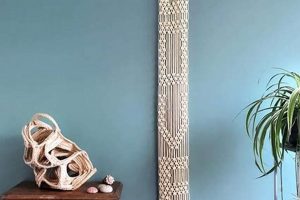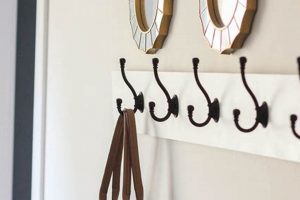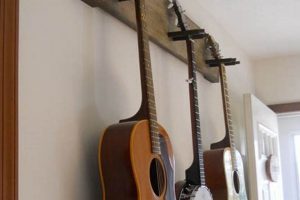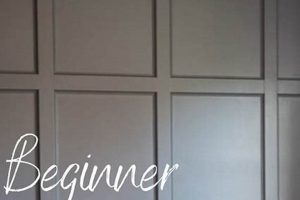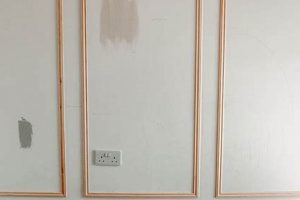The application of texture to interior walls by non-professionals represents a cost-effective method for enhancing a room’s aesthetic. This practice involves using various materials and techniques to create a surface that deviates from the standard smooth finish, adding depth and visual interest. Examples include applying joint compound with tools to achieve patterns or utilizing textured paints to conceal imperfections on existing surfaces.
This approach offers benefits such as increased customization options for interior design, the potential to increase a property’s perceived value, and the ability to mask minor surface irregularities that would otherwise require extensive repair. Historically, textured walls have been used in various cultures to add character and reflect regional design preferences. The adaptation of these techniques by individuals allows for personalized expression and creative problem-solving in home improvement.
Further exploration of material selection, tool utilization, technique application, and safety considerations are crucial for successfully undertaking projects of this nature. Understanding these elements ensures optimal outcomes and minimizes potential risks during the implementation process.
DIY Wall Texture
Achieving a professional-looking textured wall finish requires careful planning and execution. Adherence to the following tips will contribute to a successful outcome.
Tip 1: Surface Preparation is Paramount. Ensure the wall surface is clean, dry, and free from loose paint or debris. Repair any significant imperfections before applying texture. Priming the wall will promote adhesion and provide a uniform base for the texture material.
Tip 2: Material Selection Matters. Choose a texture material appropriate for the desired effect and skill level. Options include joint compound, textured paints, and specialized plasters. Consider the application method and the material’s drying time.
Tip 3: Practice Makes Perfect. Before applying texture to the entire wall, practice the chosen technique on a sample board. This allows for experimentation with different tools and patterns, minimizing errors on the final surface.
Tip 4: Employ the Right Tools. Utilize appropriate tools for the selected texture material and technique. Spatulas, trowels, brushes, and rollers can all be used to create different effects. Maintain clean tools to prevent unwanted texture variations.
Tip 5: Control the Application Thickness. Apply texture material in consistent layers to achieve a uniform pattern. Avoid over-application, which can lead to cracking or sagging. Multiple thin coats are preferable to a single thick coat.
Tip 6: Allow Adequate Drying Time. Ensure the texture material is completely dry before painting or applying a sealant. Premature finishing can compromise the texture’s integrity and result in an uneven appearance.
Tip 7: Consider Lighting. The direction and intensity of lighting can significantly impact the appearance of a textured wall. Evaluate the lighting in the room to ensure the texture complements the overall aesthetic.
Adopting these guidelines enhances the likelihood of achieving a visually appealing and durable textured wall finish. Careful execution and attention to detail are essential for a successful outcome.
The subsequent section will address common challenges encountered during the texturing process and offer solutions for mitigating these issues.
1. Material Viscosity
Material viscosity is a critical parameter in the application of wall texture. It defines a fluid’s resistance to flow, directly impacting the ease of application, the resulting texture’s appearance, and the overall durability of the finish. Understanding viscosity is paramount for achieving desired aesthetic outcomes in DIY wall texturing projects.
- Application Technique and Tool Selection
Viscosity dictates the appropriate application method. High-viscosity materials, such as thick joint compounds, generally require trowels or spatulas for application due to their resistance to flowing through spray nozzles or rollers. Low-viscosity materials, like some textured paints, are suitable for spraying or rolling. Incorrect tool selection based on viscosity can lead to uneven application, clogging of equipment, and unsatisfactory texture definition. For example, attempting to spray a high-viscosity joint compound will likely result in equipment failure and an uneven, unacceptable finish.
- Texture Pattern Definition
The viscosity of the material influences the sharpness and definition of the texture pattern. Lower viscosity materials tend to flow more readily, resulting in softer, less defined patterns. Higher viscosity materials maintain their shape better, allowing for the creation of more pronounced and intricate textures. A thin, runny texture paint may produce a subtle, blended effect, whereas a thicker, paste-like compound will create a bolder, more three-dimensional texture. This impacts the overall aesthetic of the textured wall, affecting the desired depth and visual interest.
- Coverage and Material Consumption
Viscosity affects the coverage rate and overall material consumption. High-viscosity materials generally offer greater coverage per unit volume compared to low-viscosity materials, as they tend to adhere more readily to the wall surface and minimize dripping or running. However, they may require more effort to spread evenly. Understanding the viscosity-coverage relationship allows for more accurate material estimations, reducing waste and controlling project costs. Failure to consider this aspect can lead to material shortages or overspending.
- Drying Time and Durability
Viscosity can influence drying time. Higher viscosity materials, due to their higher solids content, may take longer to dry thoroughly compared to lower viscosity materials. Inadequate drying can compromise the texture’s durability and lead to cracking or peeling over time. Furthermore, the material’s ability to bind to the wall surface can be affected. Conversely, excessively rapid drying of high-viscosity materials can also cause cracking. Selecting materials with appropriate viscosity and allowing sufficient drying time are crucial for achieving a long-lasting, resilient textured finish.
In conclusion, material viscosity serves as a foundational determinant in the success of DIY wall texturing endeavors. By carefully considering this property, individuals can optimize their application techniques, achieve the desired texture aesthetics, manage material consumption effectively, and ensure the long-term durability of their textured walls. The proper selection and handling of materials, based on their viscosity, significantly contributes to a professional-quality finish.
2. Application Technique
The application technique employed is a pivotal factor influencing the outcome of any wall texturing project. The method selected directly affects the final aesthetic, the required skill level, and the overall time commitment. Variability in technique allows for a broad spectrum of textural effects, ranging from subtle to pronounced.
- Tool Manipulation and Pressure Control
The manner in which tools are manipulated dictates the resulting pattern and texture depth. Applying consistent pressure is critical for uniform textures. Varying pressure can create intentional inconsistencies for a more rustic aesthetic. For instance, a skilled applicator using a trowel can create smooth, undulating textures by varying pressure, whereas inconsistent pressure will result in an uneven and amateurish finish. Control over the tool’s angle and movement is also paramount for achieving specific patterns.
- Material Distribution and Layering
The method of distributing the texture material across the wall’s surface is directly linked to the final appearance. Even distribution prevents pooling or thin spots, ensuring a consistent texture. Layering techniques, involving multiple applications of the material, can create depth and complexity. For example, applying a base layer of textured paint followed by a stippled layer of joint compound can produce a multi-dimensional effect. Improper distribution can lead to visible seams or uneven texture density.
- Pattern Creation and Replication
Different techniques facilitate distinct pattern creation capabilities. Stippling, using a brush or sponge, creates a random, porous texture. Swirling, achieved with a trowel or brush, generates a circular or flowing pattern. Knockdown textures involve flattening raised texture peaks with a trowel. The ability to replicate patterns consistently across the entire wall is crucial for a cohesive and professional-looking finish. Difficulty in pattern replication often results in a disjointed and visually unappealing outcome.
- Material Rheology and Application Speed
Application speed must be correlated with the rheological properties of the texturing material. Faster application speeds may be suitable for materials with low viscosity, while slower, more deliberate movements are necessary for thicker compounds. Rushing the application process can lead to air entrapment, uneven distribution, and compromised adhesion. Conversely, excessively slow application can cause the material to dry prematurely, hindering pattern creation and potentially leading to cracking. Understanding the material’s flow characteristics and adjusting application speed accordingly is essential for optimal results.
These elements highlight the intricate relationship between application technique and the resulting wall texture. Mastery of these techniques, combined with a thorough understanding of material properties, enables the creation of aesthetically pleasing and durable wall finishes. The specific choice of technique is contingent upon the desired aesthetic, the applicator’s skill level, and the inherent properties of the chosen texturing material.
3. Pattern Consistency
In the context of do-it-yourself wall texturing, pattern consistency refers to the uniformity and repetition of the applied texture across the entire surface. A lack of pattern consistency results in a visually disjointed and unprofessional appearance. Several factors contribute to inconsistent patterns, including variations in application pressure, inconsistent material thickness, and changes in tool angle. For instance, if an individual applies a swirl texture using a trowel but alters the pressure or angle mid-application, the resulting swirls will vary in size and depth, breaking the intended visual rhythm. Similarly, if joint compound is applied at differing thicknesses, some areas of the wall will exhibit a more pronounced texture than others, leading to an uneven finish. This can diminish the aesthetic impact of the wall texture.
Maintaining pattern consistency necessitates meticulous attention to detail and a consistent approach throughout the texturing process. One effective strategy is to section the wall into manageable areas and complete each section before moving on, ensuring that the same technique and pressure are applied within each area. Another approach involves using stencils or guides to aid in replicating the desired pattern consistently. The choice of texture pattern itself can also influence the difficulty of achieving consistency; simpler patterns, such as a knockdown texture, are generally easier to replicate consistently compared to more complex patterns like Venetian plaster. Regardless of the chosen pattern, practice on a sample board before applying the texture to the wall is highly recommended. This allows individuals to refine their technique and identify potential inconsistencies before committing to the final surface.
Achieving pattern consistency in DIY wall texturing presents a significant challenge, particularly for individuals with limited experience. However, the aesthetic rewards of a consistently textured wall make the effort worthwhile. By understanding the factors that contribute to inconsistencies and implementing strategies to mitigate them, individuals can significantly improve the quality of their DIY wall texturing projects. The overarching aim remains achieving a visually coherent and aesthetically pleasing textured surface, transforming a mundane wall into a noteworthy design element.
4. Drying Environment
The ambient conditions during the drying phase of a do-it-yourself wall texture application significantly impact the final result. Temperature, humidity, and airflow interact to influence the rate and manner in which the texture material cures. Elevated temperatures accelerate evaporation, potentially leading to surface cracking if the underlying layers remain damp. Conversely, high humidity slows the drying process, increasing the risk of mold growth or adhesion failure. Insufficient airflow exacerbates these issues, creating localized variations in drying rates and compromising the overall structural integrity of the textured finish. For instance, applying a textured paint in a poorly ventilated bathroom with high humidity will likely result in a prolonged drying time and an increased susceptibility to mildew.
Control over the drying environment is crucial for achieving a durable and aesthetically pleasing texture. Optimizing temperature within the manufacturer’s recommended range promotes uniform curing and minimizes the risk of surface defects. Reducing humidity levels, through the use of dehumidifiers or ventilation, facilitates faster drying and inhibits microbial growth. Ensuring adequate airflow, by opening windows or using fans, helps to remove moisture and prevent localized variations in the drying process. Consider the application of texture material during periods of stable weather conditions, avoiding extremes of heat or humidity, to promote a predictable and controlled drying environment. The selection of texture materials formulated for specific environmental conditions can also mitigate potential challenges.
In conclusion, the drying environment serves as a critical determinant in the success of DIY wall texture projects. Maintaining optimal conditions, through careful monitoring and control, ensures proper curing, minimizes the risk of defects, and enhances the longevity of the textured finish. The interplay between temperature, humidity, and airflow directly influences the quality and durability of the final product, underscoring the importance of considering these factors during the planning and execution phases of the project. Failure to manage the drying environment effectively can compromise the structural integrity and aesthetic appeal of the textured wall, resulting in costly rework and a diminished final outcome.
5. Surface Adhesion
Surface adhesion is a fundamental prerequisite for the successful application of any DIY wall texture. Inadequate adhesion precipitates a cascade of adverse effects, culminating in premature failure of the texture. The applied material, whether joint compound, textured paint, or specialized plaster, must establish a robust mechanical and chemical bond with the underlying substrate to ensure longevity and prevent delamination. Contaminants, such as dust, grease, or residual paint, impede this bond formation, acting as a barrier between the texture material and the wall surface. Consequently, the texture may exhibit peeling, cracking, or blistering shortly after application. A practical example illustrating this principle is the application of texture over a glossy paint surface without proper sanding or priming. The lack of surface roughness inhibits the formation of a strong mechanical bond, resulting in the texture detaching over time.
The preparation phase directly influences surface adhesion in DIY wall texture projects. Thorough cleaning, sanding, and priming are essential steps to ensure optimal bonding. Cleaning removes contaminants, sanding creates a mechanical key for the texture to grip, and priming seals the surface and provides a uniform base for adhesion. Different substrates necessitate specific priming techniques. For porous surfaces like drywall, a standard latex primer is often sufficient. Non-porous surfaces, such as previously painted walls with a glossy finish, require a bonding primer designed to enhance adhesion. Moreover, the type of texture material also impacts adhesion requirements. Heavier textures necessitate more rigorous surface preparation compared to lighter textures. The correct primer selection is also important. For instance, oil-based primers are best for stain blocking, while latex-based primers are suited for general use.
In summary, surface adhesion serves as the cornerstone of a durable and visually appealing DIY wall texture. Proper surface preparation, including cleaning, sanding, and priming, is not merely a preparatory step but an integral component of the texturing process. Understanding the interplay between surface conditions, priming techniques, and texture material properties is crucial for mitigating adhesion-related failures and ensuring a long-lasting, professional-quality finish. Overlooking this aspect results in compromised structural integrity and necessitates costly repairs. Successful execution necessitates a systematic and meticulous approach to surface preparation, recognizing the critical role of adhesion in the overall success of the DIY wall texture project.
Frequently Asked Questions
The following addresses common inquiries regarding the application of wall texture by individuals. These answers provide informational guidance for achieving optimal results.
Question 1: Is specialized equipment required for most application techniques?
While some specialized tools can enhance efficiency and create unique textures, many basic techniques can be executed with readily available tools such as trowels, brushes, and sponges. The specific tools needed depend on the desired texture and the chosen material.
Question 2: What is the approximate drying time for textured walls?
Drying time varies considerably based on the texture material used, the thickness of application, and ambient environmental conditions. Generally, a minimum of 24 to 48 hours is required for complete drying before subsequent painting or sealing. Consult the product manufacturer’s guidelines for specific drying recommendations.
Question 3: Can a textured wall be applied over existing wallpaper?
Application over wallpaper is generally not recommended. Wallpaper can compromise adhesion and may detach over time, causing the texture to fail. Removal of the wallpaper and proper surface preparation are essential for a durable and long-lasting texture.
Question 4: How can previously textured walls be repaired?
Repairing previously textured walls involves matching the existing texture as closely as possible. This may require practicing the original application technique on a sample board. The damaged area should be cleaned, primed, and then textured to blend seamlessly with the surrounding surface.
Question 5: Is it possible to apply a texture over a wall with minor imperfections?
Texturing can effectively conceal minor imperfections, such as small dents or hairline cracks. However, significant damage should be repaired prior to texturing to ensure a structurally sound and aesthetically pleasing finish. Texturing is not a substitute for proper wall repair.
Question 6: What safety precautions should be observed during the texturing process?
Appropriate safety measures include wearing protective eyewear and a dust mask to prevent inhalation of particles. Adequate ventilation is essential, particularly when working with solvent-based materials. Consult the material safety data sheet (MSDS) for specific safety recommendations related to the chosen texture material.
These FAQs address critical considerations for achieving a successful textured wall finish. Diligence and adherence to best practices are essential.
The following segment will delve into cost analysis and material selection specific to common DIY wall texture applications.
Conclusion
This exposition has explored the multifaceted aspects of do-it-yourself wall texture. The analysis has encompassed surface preparation, material selection, application techniques, environmental considerations during drying, and the critical role of surface adhesion. Understanding these elements is paramount for achieving a successful and aesthetically pleasing result. Inconsistent application, inadequate preparation, or failure to control environmental factors can compromise the integrity of the texture and lead to premature failure. Emphasis has been placed on the interdependency of each stage in the process, highlighting the need for a holistic approach.
The informed application of DIY wall texture offers individuals a means to personalize their living spaces and enhance the visual appeal of their homes. Careful planning, diligent execution, and a thorough understanding of the materials and techniques involved are essential for achieving a professional-quality finish. Continued learning and adherence to industry best practices will further refine skills and ensure long-lasting, visually striking results.



